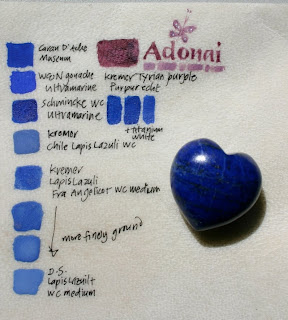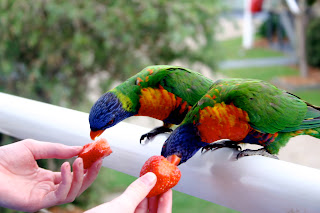I have some colour lightfastness samples for my new pencils that will be ready for review next time. An interesting article popped up in The Wall Street Journal last week on coloured pencil history! The title: As Pencil Makers Push the Envelope, Age Old Rivalry Stays Sharp. Faber-Castell and Staedtler are serious competitors, the article and video are good fun.
Wednesday, October 06, 2010
Quills & Conservation
I have some colour lightfastness samples for my new pencils that will be ready for review next time. An interesting article popped up in The Wall Street Journal last week on coloured pencil history! The title: As Pencil Makers Push the Envelope, Age Old Rivalry Stays Sharp. Faber-Castell and Staedtler are serious competitors, the article and video are good fun.
Friday, April 02, 2010
Scriptrix Scribblings
Here you can see the colours on vellum, with a small lapis heart. I have compared the lapis with modern ultramarine pigments. The Kremer lapis pigment has been purified according to Cennini’s recipe.
I wanted to incorporate something Welsh, so I chose to do the Welsh title in lettering based on the work of the renowned Welsh artist, David Jones.
The old world style of the poem was reflected in a gothic style hand for the script. Gothic is something I never normally get to use, so it was interesting to do some extended writing in it.
The pencils themselves are made using a most beautiful light ash coloured wood with a silky varnish which is lovely to hold. The feel of them is unlike any other pencils I have used before. The leads are soft, with a slight bit of flaking when you use them; opaque and brilliant in colour.
So, here is my play with the pencils and my water colours following my garden flowers colour scheme.
I’m very happy with the Luminance pencils so far. I’ll be very interested to see how they respond to my lightfastness testing, given their claim to exceptional lightfastness properties.
If you are wondering, "Scriptrix" is the Latin feminine term for a scribe. An example, is a manuscript of moral treatises and sermons copied around 1100 by a nun who signed herself as "scriptrix", (Wemple, S. F. & Reno, C.M., Scribes and Scriptoria, in "Women in the Middle Ages" (2004) eds. Wilson, K. M. & Margolis, N., Greenwood Press, London, p. 831; the original manuscript is Oxford, Bodleian Library, Bodley 451). "Scripsit" is the Latin masculine term for a scribe and has historic usage by women and men. "Scriptor" is another masculine term for a scribe.
Saturday, January 16, 2010
Princes, Protocol & Pencils

It seems such an age in many ways since my last entry. Luke, my little cherub, is now almost two and into everything. His birth seemed to usher in many changes to our lives. For my husband, it was a change from full time student, to looking for a full time job. The best job available was in Wellington, so for all of us it involved selling a house and buying a new house in Wellington, with the entire family moving in November 2008. For the girls, a new school. For me, it meant leaving family, friends and my Auckland clients. For someone like me who doesn’t like change, it was a lot of change.
Although many of my Auckland clients continue to send me work in Wellington, it has been nice to finally have some new Wellington clients. A highlight and privilege has been starting to do work for New Zealand Parliament. This has included some work around Prince William’s New Zealand visit that has started today.
It always is a delight to be the agent in creating something special for another’s loved ones. Wedding vows and special poems that are gifted to people for their anniversaries, birthdays or Christmas are really a privilege to complete.
One highlight of November/ December 2009, was finally getting to meet Charles Pearce. I have had two of his books, “ A Little Manual of Calligraphy”, and “The Anatomy of Letters”, ever since I started calligraphy and they have always been a solid and useful example of fine lettering. The double spread page of flourished Italic from “The Anatomy of Letters” continues to be the pinnacle to which I aim in flourishing. Charles himself was a delight, as well as a reflective and instructive teacher.
His workshop in Wellington “Pen Manipulation Techniques”, taught a modified foundational hand, which exposed me to some pen manipulations I’d never met before. The strength and subtle beauty of the hand grew on me, as well as being delighted by the beautiful, fluid forms that Charles managed to conjure out of a broad edged nib. You would have thought it was a brush.
We have just returned from two warm weeks in Sydney over Christmas and New Year. One highlight was having sulphur-crested cockatoos and rainbow lorikeets as our breakfast companions. Another was trailing around a number of Sydney art shops. Unfortunately, Wills Quills wasn’t open over the time we were there, but I particularly liked Parkers, hidden in Sydney’s historic Rocks area, and Oxford Art Supplies in Chatswood, which also had a very impressive bookshop.
Pantone recently indicated turquoise to be the colour for 2010. So for Christmas I received an interesting piece of food and travel writing by the same name, “Turquoise: A chef’s travels in Turkey” by Greg and Lucy Malouf (Hardie Grant books 2007). I have always been interested in Turkey, and Persian manuscripts, so I look forward to learning more about its history and culture.

I am always interested in any new developments on the colour pencil market. For some time I have been interested in the Caran D’Ache “Museum” range of coloured pencil leads, which claims to be a premium range in terms of quality and light fastness. The fact you need to purchase a separate, and expensive, lead holder has always put me off until this summer, when I finally bit the bullet and purchased some. I have found the colours to be beautiful as well as intense, and the leads are if anything, very soft to work with. They are also water soluble which gives you another range of fun options to try out.
Their only draw back is that they are loose leads which need to be interchanged in the lead holder. Being a person who tends to work in the fast and furious mode, this is really a bugbear. It is interesting that Caran D’Ache has recently put out a new premium range “Luminance”, which comes in the more usual form of wooden pencils. It makes me wonder if the “Museum” range, with its separate lead holder, hasn’t been popular. I have ordered some of the “Luminance” pencils from overseas, as nobody in New Zealand stocks them, and I look forward to trying them out.
Another interesting find while perusing the art shops in Sydney, was the Old Holland range of watercolours. I have seen the Old Holland oils in New Zealand but I didn’t realise they had a watercolour range. The enormous range and intensity of their colours looked very impressive on the actual colour chart at the shop, and they claim to be 100% light-fast, which seems a little bold to me. They were tempting enough for me to buy a few to check out. My initial reaction is that they are very nice to work with.

I came home with a book I hadn’t heard of at all; “Calligraphy: A Book of Contemporary Inspiration” by Denise Lach ( Thames & Hudson, 2009). The book is an inspiration, not only for the mainly abstract lettering of a textural nature with a variety of tools, but for the wonderful photos of natural patterns, from a close up of a leaf’s veins to an image of the pattern tide and wind leave in the sand.
Many friends helped out enormously when little Luke was born. Theresa Cashmore helped in so many ways with clients, and at the drop of a hat, with tutoring an overseas calligraphy student. Dr Allan Taylor helped me to sort through the muddle that was my head at the time. Rev Stan Thorburn also helped us at this time. Many school mums and church friends helped in umpteen small ways that made life manageable in the upheaval.
Wellington, now seems more like home. I enjoy the beautiful Wellington harbour in all its many faces; brilliant sun to impressive storms, although the wind and cold takes some getting used to sometimes. I enjoy our small community of Eastbourne, and its relatively remote and serene, peaceful location, despite being a half hour drive from Wellington city. We live in Rona Bay, surrounded by a strong bay of steep bush covered hills with the beach before us. There are birds; moreporks calling at night; tuis, bellbirds and fat woodpigeons by day with the odd kingfisher; seagulls, shags, herons and oystercatchers by the seaside.
I hope the new year continues in the fresh way that new years do, and I get to add to this column a little more regularly.




























